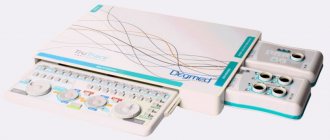What is Arnold-Chiari Malformation?
Arnold-Chiari malformation is a condition in which a part of the brain at the back of the skull, called the cerebellum, protrudes through the foramen magnum into the spinal canal (normally through this opening the spinal cord exits the skull).
This protrusion of part of the cerebellum creates a disruption in the outflow of cerebrospinal fluid (CSF) from the cranial cavity, which can cause increased intracranial pressure with the development of hydrocephalus and symptoms of varying severity. In most cases, this problem is congenital.
In rare cases, malformation may develop at a later age, in which case it is referred to as acquired or secondary malformation.
There are several types of Arnold-Chiari malformation, but the most common is type I, also called primary Arnold-Chiari malformation type I. Although it is congenital, the first symptoms of the disease may appear in infancy or early childhood, but they are most often detected in adolescence or early adulthood.
Get an MRI of the brain in St. Petersburg
Treatment
In asymptomatic cases, constant monitoring with regular ultrasound and radiographic examination is indicated. If the only sign of an abnormality is minor pain, the patient is prescribed conservative treatment. It includes a variety of options using non-steroidal anti-inflammatory drugs and muscle relaxants. The most common NSAIDs include Ibuprofen and Diclofenac.
You cannot prescribe painkillers yourself, as they have a number of contraindications (for example, peptic ulcer). If there is any contraindication, the doctor will select an alternative treatment option. Dehydration therapy is prescribed from time to time. If there is no effect from such treatment within two to three months, surgery is performed (expansion of the foramen magnum, removal of the vertebral arch, etc.). In this case, a strictly individual approach is required to avoid both unnecessary intervention and delays in surgery.
Treatment tactics for each patient require an individual approach
In some patients, surgical exploration is the way to make a definitive diagnosis. The purpose of the intervention is to eliminate compression of the nerve structures and normalize cerebrospinal fluid dynamics. This treatment results in significant improvement in two to three patients. The expansion of the cranial fossa helps to eliminate headaches and restore tactility and mobility.
A favorable prognostic sign is the location of the cerebellum above the C1 vertebra and the presence of only cerebellar symptoms. Relapses may occur within three years after the intervention. Such patients are assigned a disability by decision of the medical and social commission.
Causes of Arnold-Chiari malformation type I
The exact causes of Arnold-Chiari malformation type I are not known. The problem may arise during fetal development due to some defect, presumably associated with exposure of the fetus to harmful substances. But it is possible that the appearance of the disease is caused by heredity and genetic mutations.
Arnold-Chiari malformation type I occurs after birth. Its causes are the flow of cerebrospinal fluid into the lumbar or thoracic spine. This usually occurs due to injury, infection, or exposure to harmful substances.
Prediction of Chiari malformation
The prognosis for a patient with Chiari malformation depends on what type of pathology was detected in him. For example, patients with Chiari malformation type 1 may not need special treatment for the rest of their lives. However, if patients who have been diagnosed with type 1 or 2 of the disease develop severe symptoms, they urgently need to be examined by a neurologist. A timely operation will help avoid serious complications. Chiari malformation type 3 is practically untreatable and very often leads to the death of the patient.
The disease can be accompanied by a number of serious complications. In particular, the patient may be diagnosed with an increase in intracranial hypertension, as well as accumulation of fluid in the cranial cavity (hypertensive-hydrocephalic syndrome). Because some patients with Chiari malformation are unable to ambulate, they are likely to develop congestive pneumonia. In the case of a complex course of the disease, breathing disturbances and even respiratory arrest may occur.
Symptoms and manifestations of Arnold-Chiari type malformation
The main manifestations of malformation are:
- Syrinx. This formation is a fluid-filled cavity in the spinal cord (syringomyelia) or cysts. As it grows, this formation puts more and more pressure on the spinal cord. In some cases, this can lead to impaired neuromuscular functions and weakness of the limbs. Difficulty moving or breathing. To clarify this diagnosis, patients are prescribed magnetic resonance imaging.
- Scoliosis. In children under 16 years of age, in whom the formation of the spine has not yet completed, as a result of the appearance of cavities, lateral curvature of the spine (scoliosis) may occur.
- Headache . Children up to and including adolescence with undiagnosed Arnold-Chiari malformation type 1 may experience headaches localized to the back of the head and neck, aggravated by exercise.
- Sleep apnea. With this symptom, a short-term cessation of breathing is observed during the patient’s sleep. The presence of this symptom can be determined during a sleep study of the patient.
Other symptoms include hoarseness, difficulty breathing, rapid side-to-side eye movements, muscle weakness, difficulty maintaining balance, abnormal reflexes, and neurological problems including paralysis.
In children
The block most commonly noted is within the ventricular system and is noncommunicating hydrocephalus . This is usually caused by a narrowing of the Sylvian aqueduct or underdevelopment of the foramina of Magendie and Luschka. As a generalized disorder of the development of the nervous system, it can be combined with micro- or macrogyria, porencephaly, agenesis of the corpus callosum, fusion of the cerebral hemispheres, agenesis of the cerebellar vermis, vertebral clefts, meningocele, encephalocele, syringomyelia, hydromyelia . The cause of communicating hydrocephalus may be the formation of adhesions in the subarachnoid region at the base of the brain, perinatal subarachnoid or intraventricular hemorrhages.
The syndrome in children can occur as a result of traumatic injuries to the sphenoid-occipital and sphenoid-ethmoid region due to birth injuries. Clinical manifestations include feeding disorders ( reflux and aspiration ), episodes of apnea , stridor , cranial innervation disorders, and seizures resistant to anticonvulsants.
Arnold Chiari syndrome in the fetus
Chiari pathology is a congenital osteoneuropathy and is formed at the stage of formation and development of the neural tube in the fetus, asynchronous formation of the nerve trunk and bones of the cranial fossa.
The morphological manifestations of this pathology can be identified during an ultrasound examination and determine the further prognosis. Most often, the detection of pathology becomes the reason for termination of pregnancy.
Diagnosis of Arnold-Chiari malformation type I
If the disease is asymptomatic, it can be detected during examinations (computer or magnetic resonance imaging) prescribed by a doctor for other diseases. If there are symptoms and suspicion of Arnold-Chiari malformation type 1, the doctor will refer the patient for a CT or MRI. A CT scan creates a three-dimensional image of an area of the body using X-rays, while an MRI uses a powerful magnetic field for this purpose. The resulting images are processed using a computer, creating three-dimensional visualization.
Get an MRI of the brain in St. Petersburg
First month after surgery
During the first month after surgery, the patient is still in the early stages of recovery. As a rule, if the operation is successful, there is an improvement in the patient’s condition and regression of neurological symptoms. In most patients, pain goes away within 1-2 weeks after surgery, but in some it may persist for 1 month or more. Such patients are prescribed various painkillers. During the first month after surgery, patients should maintain a sedentary lifestyle, avoid physical activity and, if possible, spend time in the fresh air.
During this period, the development of the complications described above (cerebrospinal fluid leakage, inflammation, etc.) is also possible. If signs of inflammation appear in the area of the postoperative wound, such as pain, swelling and redness, or fluid discharge from it, you should immediately inform your doctor.
Treatment of Arnold-Chiari malformation type I
Typically, the treatment method for the disease depends on the symptoms and their severity, the general health of the patient and his age:
- If there are no symptoms, doctors carefully monitor the patient's health with frequent examinations or regular MRIs.
- If symptoms occur, your doctor may prescribe pain medication or suggest surgery to relieve pressure on the brain and restore normal flow of cerebrospinal fluid.
- If you have few or no symptoms but have fluid-filled cavities, your doctor may order an MRI with contrast. This type of MRI is excellent for examining the flow of cerebrospinal fluid and identifying areas where these flows are blocked. If symptoms worsen, surgery may be suggested.
- If there are signs of sleep apnea, a sleep study is performed, based on which the doctor develops a further treatment plan.
Diagnostic measures
Arnold-Chiari malformation on an MRI image
Neurologists and neuropathologists examine the patient and identify characteristic gait features, changes in reflexes and sensitivity in certain areas of the body, weakness in the arms and other signs. All manifestations of cerebellar, hydrocephalic, bulbar and other syndromes taken together allow the doctor to suspect an anomaly.
After determining the patient’s neurological status, a comprehensive neurological examination is required, including instrumental methods - electroencephalography, ultrasound of the brain, rheoencephalography, angiography, radiography. These techniques reveal only indirect signs of pathology - changes occurring in the patient’s body.
Nuclear magnetic resonance underlies a special non-radiological research method - tomography. This spectroscopic test is safe for most people. It produces an image consisting of thin slices from the magnetic resonance signal passing through the human body. Today, MRI allows for a quick and accurate diagnosis. Tomography visualizes the structure of bones and soft tissues of the skull, determines defects of the brain and its blood vessels.
Second opinion for Arnold-Chiari malformation type I
Despite the fact that the malformation is clearly visible on MRI and CT, errors often occur during these examinations. Some of them are related to the use of outdated equipment or its poor performance. These are objective reasons. Subjective reasons include the fact that doctors often cannot make the correct diagnosis based on MRI and CT. For example, the diagnosis of Arnold-Chiari malformation is often made in children with a simple low location of the cerebellar tonsils (a normal variant), or can be confused with other anomalies of the craniospinal junction. In addition, the description of MRI images may be performed inaccurately and incorrectly by the radiologist.
If we talk about experience, then in a city of half a million there may be an average of 25 people with Arnold-Chiari malformation, and doctors rarely observe this condition. Therefore, when looking at the results of CT and MRI, they may assume diseases that are more familiar to them, which will lead to incorrect treatment, wasted money, wasted time and health.
In order to avoid misdiagnosis, it is vital for the patient to obtain a second opinion on the scan results and it is advisable that this opinion be from a doctor of higher qualifications than the doctor who gave the first opinion.
The National Teleradiological Network (NTRS) provides every patient with free access to obtain an alternative opinion from leading specialists in the field of radiology (radiodiagnostics) and magnetic resonance imaging. No matter where you are, all you need is access to the Internet and scan results in electronic form. Upload them to our server and within a day you will receive the most qualified conclusion that can be obtained in our country.
NTRS is your opportunity to avoid misdiagnosis and treatment.
Preventive measures
Prevention of the occurrence of the syndrome lies in the careful attitude of the pregnant woman to her health and the health of the baby. She is advised to eat healthy foods and stop smoking and drinking alcohol. The recommendations of the attending physician must be followed in full, this also applies to taking medications. All this will help reduce the likelihood of developmental defects in the baby to a minimum.
Arnold Chiari syndrome is a very rare birth defect. But with timely diagnosis and treatment of this disease, you can almost completely get rid of neurological manifestations and become a healthy person. Therefore, it is so necessary to promptly contact highly specialized clinics, such as Israeli clinics.








